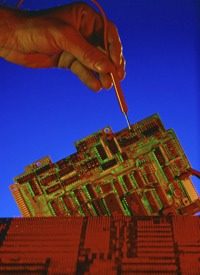
In order to meet the demand for ever smaller and faster computer chips, IBM and the California Institute of Technology have been researching the use of DNA molecules in microprocessors. It turns out that the building blocks of life may help keep alive Moore’s Law that computer performance doubles every two years.
IBM researchers and Caltech scientists have found that “the tiny components that run along a chip’s silicone surface will self-adhere to previously laid down DNA patterns,” according to an August 17 InformationWeek story. This means that microchip designers can use DNA as a complex framework to which microscopic materials can be added to form a computer chip.
Such incredibly small-scale chip construction would be one way for computer processing speed to continue its current pace in accordance with Moore’s Law. Intel co-founder Gordon Moore predicted back in 1965 that the number of transistors on a computer chip would double about every two years. Roughly speaking, double the transistors equals double the computer performance for the same price.
For the past two decades, this pace has been kept up primarily by decreasing the size of chip components. Now that these parts have become microscopic, it is becoming harder to keep doubling the transistors by shrinking their size. “The cost involved in shrinking features to improve performance is a limiting factor in keeping pace with Moore’s Law and a concern across the semiconductor industry,” said Spike Narayan, Science & Technology manager at IBM’s Almaden research lab in San Jose, California.
Narayan thinks that the DNA-based microchip design being pioneered by IBM and Caltech could be the breakthrough needed to keep Moore’s prediction on track: “The combination of this directed self-assembly with today’s fabrication technology could lead to substantial savings in the most expensive and challenging part of the chip-making process.”
CNET noted on August 17 that “new chip plants typically cost billions of dollars to build, and the tab goes up as chip circuits get smaller.” But IBM sees a better return on investment with DNA-based chip construction: “The utility of this approach lies in the fact that the positioned DNA nanostructures can serve as scaffolds, or miniature circuit boards, for the precise assembly of components, such as carbon nanotubes, nanowires, and nanoparticles.”
No mention was made as to the source of the DNA molecules or whether they would in any way be subject to mutation as can happen in a living organism. InformationWeek said IBM plans to publish its research in the September issue of Nature Nanotechnology. It will be interesting to learn the specifics of how they propose to make good things come in such very, very small packages.



